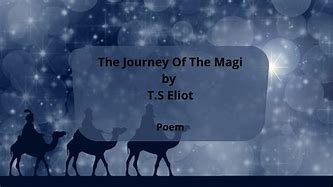is a profound and introspective poem that explores the story of the three wise men, or Magi, who journeyed to witness the birth of Jesus Christ. Written in 1927, the poem is one of Eliot’s most celebrated works and is often regarded as a modernist classic. It delves into themes of spiritual transformation, the burden of faith, and the inherent tension between the past and the future.
Summary of “The Journey of the Magi”
The poem is narrated by one of the three Magi who recounts the journey to Bethlehem to visit the newborn Christ. The journey is long, arduous, and filled with hardship. The Magus reflects on the difficulty of the pilgrimage and expresses his disillusionment with the event, questioning its meaning and the changes it has brought to his life. The poem conveys the sense of physical and spiritual struggle that the Magi undergo as they venture toward a new understanding of the world, represented by the birth of Christ.
The journey to Bethlehem symbolizes a passage from an old way of life to a new one, and the Magus’ reflections embody the discomfort and uncertainty that often accompany spiritual transformation. Despite the difficulty, the arrival at the birth of Christ signals the beginning of a new spiritual era, though the narrator is left with a sense of ambivalence and unease about what the future holds.
Themes in “The Journey of the Magi”
- Spiritual Transformation: The central theme of the poem is the transformation the Magi experience on their journey. They are not only traveling physically to witness the birth of Christ but are also undergoing a spiritual journey that challenges their old beliefs and ways of thinking. The birth of Christ represents a new beginning, but it also requires a rejection of the past, which is symbolized by the difficulties and struggles they face during their journey.
- Disillusionment and Doubt: Throughout the poem, the Magus expresses doubt and disillusionment with the experience. He questions the significance of the event and the sacrifice it has required. This sense of uncertainty reflects Eliot’s exploration of the human condition and the complexities of faith. The Magus, rather than embracing a clear sense of revelation, seems to find himself torn between the promise of something new and the loss of something familiar.
- The Burden of Faith: The poem also touches on the burden that faith can bring. For the Magi, the journey is not simply one of physical travel but a spiritual pilgrimage that demands great sacrifice. The arrival at the stable is not the end of the journey but the beginning of a new phase of their lives, one that requires a reevaluation of their beliefs and a confrontation with the harsh realities of faith.
- The Tension Between the Old and New: Eliot emphasizes the tension between the old world and the new world represented by Christ’s birth. The Magus reflects on the journey as something that marks the end of an era and the dawn of a new one. This tension is conveyed through imagery of death and rebirth, with the Magus’ journey representing both a literal and metaphorical crossing from one way of life to another.
- The Uncertainty of Spiritual Revelation: Eliot suggests that spiritual revelation is not always clear or immediate. The Magus does not experience an immediate sense of joy or clarity upon witnessing the birth of Christ. Instead, the revelation is unsettling and difficult to comprehend. This complexity reflects the modernist concern with the fragmented, ambiguous nature of the human experience and the struggle to find meaning in a complex world.
Notable Literary Devices in “The Journey of the Magi”
- Allusion: The poem makes several references to the Biblical story of the Magi and the Nativity. These allusions help to deepen the spiritual and religious significance of the journey and provide a cultural context for the Magus’ transformation.
- Imagery: Eliot uses vivid imagery to convey the harshness of the journey, the discomfort of the Magi, and the starkness of the environment. Descriptions of the cold, barren landscape and the difficulty of the journey emphasize the struggles the Magi face and the spiritual cost of their pilgrimage.
- Symbolism: The journey itself is a symbol of the spiritual pilgrimage the Magi undertake. The stable where Christ is born symbolizes a new beginning, and the discomfort and struggle of the journey represent the challenges of spiritual awakening and transformation.
Irony: There is a sense of irony throughout the poem, particularly in the Magus’ ambivalence toward the birth of Christ. Rather than experiencing the joy and fulfillment expected from such an event, the Magus is left with a sense of unease, which highlights the complexity of faith and spiritual revelation.
“The Journey of the Magi”
by T.S. Eliot
A cold coming we had of it,
Just the worst time of the year
For a journey, and such a long journey:
The ways deep and the weather sharp,
The very dead of winter.
And the camels galled, sore-footed, refractory,
Lying down in the melting snow.
There were times we regretted
The summer palaces on the slopes, the terraces,
And the silken girls bringing sherbet.
Then the camel men cursing and grumbling
And running away, and wanting their liquor and women,
And the night-fires going out, and the lack of shelters,
And the city of Bethlehem, that was also a tomb,
And the final recognition that we had arrived at the birth
Of a new reality, the undoing of the old,
In a space no longer bound by time.
Conclusion
T.S. Eliot’s The Journey of the Magi is a meditation on the challenges of spiritual transformation and the tension between the past and the future. Through the journey of the Magi, Eliot explores the difficulty and uncertainty that often accompany moments of spiritual revelation. The poem invites readers to reflect on the complexities of faith, the burdens of spiritual awakening, and the ongoing struggle to find meaning in a changing world.

